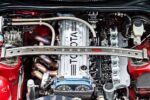Chevy 2.2 Engine Overview
A Brief History
The Chevy 2.2 engine, part of General Motors’ Ecotec family, was introduced in the mid-1990s as a compact, fuel-efficient powerplant designed for a variety of vehicles. This four-cylinder engine quickly became a popular choice for models like the Chevrolet Cavalier and the Pontiac Sunfire, appealing to drivers seeking reliability and economy. With a displacement of 2.2 liters, it was engineered to deliver a balance of performance and efficiency, making it a staple in GM’s lineup for several years.
As the automotive industry evolved, the 2.2 engine underwent various updates and modifications to meet changing emissions standards and consumer demands. Despite its initial success, the engine’s reputation has been marred by a series of common problems that have surfaced over time. These issues range from minor inconveniences to significant mechanical failures, leading many owners to question the long-term viability of this engine.
While the Chevy 2.2 engine was designed to be a workhorse, its performance has been inconsistent across different models and production years. Understanding the prevalent problems associated with this engine is crucial for current and prospective owners. Whether you’re dealing with a persistent check engine light or experiencing a drop in power, being aware of these issues can save you time, money, and frustration in the long run. This article will delve into the specific problems that plague the Chevy 2.2 engine, providing an unfiltered look at what owners can expect.
Common Issues with the Chevy 2.2 Engine
The Chevy 2.2 engine, while designed for efficiency and reliability, has been plagued by a variety of issues that can affect performance and longevity. Understanding these problems is essential for anyone considering purchasing a vehicle equipped with this engine or for current owners facing difficulties. Below are some of the most common problems associated with the Chevy 2.2 engine.
1. Oil Consumption
One of the most frequently reported issues with the Chevy 2.2 engine is excessive oil consumption. Many owners have noted that their engines burn oil at an alarming rate, leading to the need for frequent top-ups. This problem can stem from:
- Worn piston rings
- Valve guide wear
- Faulty PCV (Positive Crankcase Ventilation) system
If left unaddressed, excessive oil consumption can lead to more severe engine damage and costly repairs.
2. Timing Chain Problems
The timing chain in the Chevy 2.2 engine is known to stretch over time, which can lead to a host of issues, including:
- Engine misfires
- Rough idling
- Loss of power
A stretched timing chain can also result in catastrophic engine failure if it snaps, making it crucial to monitor for signs of wear.
3. Head Gasket Failure
Another significant issue with the Chevy 2.2 engine is head gasket failure. Symptoms of a failing head gasket include:
- Overheating
- White smoke from the exhaust
- Milky oil
Head gasket failure can lead to severe engine damage if not addressed promptly, often requiring a complete engine rebuild.
4. Fuel Injector Problems
Fuel injectors in the Chevy 2.2 engine can become clogged or fail, leading to poor fuel economy and performance issues. Symptoms include:
- Engine hesitation
- Rough idling
- Decreased acceleration
Regular maintenance and cleaning can help mitigate these issues, but replacement may be necessary in severe cases.
5. Ignition System Failures
Issues with the ignition system can also plague the Chevy 2.2 engine. Common problems include:
- Faulty spark plugs
- Worn ignition coils
- Bad wiring connections
These failures can lead to misfires and poor engine performance, necessitating timely diagnosis and repair.
Symptoms and Consequences
Understanding the symptoms associated with these problems can help owners take proactive measures to avoid more significant issues down the line. Below is a table summarizing common symptoms and their potential consequences.
| Symptom | Possible Consequence |
|---|---|
| Excessive oil consumption | Engine damage due to low oil levels |
| Rough idling or misfires | Loss of power and increased emissions |
| Overheating | Severe engine damage or failure |
| White smoke from exhaust | Potential head gasket failure |
| Engine hesitation | Poor acceleration and fuel economy |




0 Comments